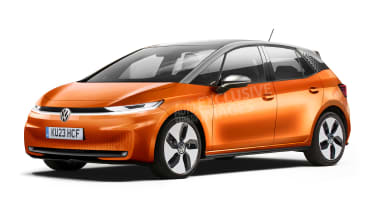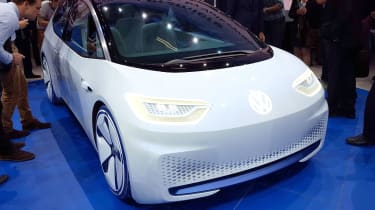Volkswagen has pushed back the launch of the ID.1 supermini to get the ID.Buzz minibus on sale next year
Volkswagen has confirmed that plans for a pure-electric ‘ID.1’ supermini have been delayed by a couple of years, with the introduction of the new ID.Buzz minibus in 2022 taking priority.
The firm’s all-electric alternative for the Polo – speculatively named ID.1 – has been pushed back to the mid part of the decade, according to VW passenger cars boss Ralf Brandstatter.
Best electric cars to buy 2021
“Plans for an electric car under the ID.3 – with an entry-level price starting at €20,000 (£17,300) – are pushed up by two years to 2025,” said the VW executive, during the firm’s latest strategy update.
The electric supermini is likely to use an adapted version of the Group’s MEB platform and will occupy a similar footprint to the Volkswagen Polo, although the packaging benefits of the electric underpinnings mean it could have as much space as a Golf.
Volkswagen hasn’t confirmed an official reason for the delay, but the firm is said to be struggling with the car’s battery chemistry. There’s also doubt over whether Volkswagen can achieve a suitable profit at the EV’s targeted €20,000 (£17,300) starting price.
If all goes to plan and Volkswagen meets its 2025 deadline, the ID.1 will act as a direct competitor to the Peugeot e-208 and the Vauxhall Corsa-e. The hatchback would also play a key role in VW’s latest expectation for EVs to make up 70 percent of its European sales by 2030, given the continued popularity of the B-segment in Europe.
Once the ID.1 is on the market, it’ll be joined by a new B-segment crossover based on the same underpinnings, potentially called the ID.2. However, this crossover’s existence is entirely dependent on Volkswagen meeting its targets with the ID.1’s development costs.
New Volkswagen ID.1: platform and powertrain
Official details on Volkswagen’s Polo-sized electric hatchback are still thin on the ground but, over the last year, executives have dropped a few hints about what the future could hold.
In 2019, SEAT was appointed by Volkswagen to lead the development of the two entry-level MEB cars. Former technical development boss Axel Andorff (who is now in charge of Skoda’s MEB product line), told Auto Express that it would make sense for the project to deliver similar packaging gains as the ID.3, potentially producing small electric superminis with the same space inside as a Golf.
Andorff told Auto Express, “If you set up a totally new platform, why shouldn’t you use the advantages of this platform?” However, he added that the project would need to make significant savings over the MEB platform to make the finished cars financially viable.
“Nobody can do this on their own,” he said. “We’re relying on the experiences that the team already has from MEB. But we also know that just a little improvement of the MEB, on costs and so on, will not be sufficient for what we need for a small battery-electric vehicle.”
Volkswagen has since taken responsibility for the development of the MEB entry-level cars back from SEAT.
Similarly Former VW Group technical development boss Dr Frank Welsch (now head of group quality management and strategy), previously revealed to Auto Express how costs would be king in the development of smaller cars on the MEB platform.
He said: “Every two or three years, we see improvements in battery technology and electrochemistry. If we speak about [a smaller] MEB entry, I don’t think it would happen before 2023 – and there will be at least some improvements by then.
“But if you go for a smaller concept, where they don’t need a range of 500km, or where they could never afford a battery capacity of 80kWh, for example, it could be a possibility – especially when you keep in mind it should improve over the next three years.
“We are happy with the tech we have for the first wave of ID. – and now we’re looking again at how we could bring the costs down. It’s no use going down from Golf-size to Polo-size, and then saying: ‘We’ve saved 50 euros on the bare chassis.’ We have to look across everything. Could we offer it with a smaller motor? It’s a smaller car, and you can get a Polo with lower-powered engines than you can get in a Golf.”
However, despite a focus on lower-powered batteries and less potent motors, Welsch didn’t rule out the possibility of offering a longer-range version of the ID.1. He said: “Because it’s part of MEB, we can still have larger capacities [of battery].
“We wouldn’t need to stop at 40kWh, for example – if I have the space between the axles, I can use it. So even with a smaller wheelbase I could imagine going for, say, 60kWh, because we know from the Polo that some customers of that size of vehicle do want to go for longer journeys as well.”
Now read our review of the pure-electric Volkswagen ID.3 hatchback. Let us know your thoughts in the comments section below…
Source: Read Full Article



 Best electric cars to buy 2021
Best electric cars to buy 2021